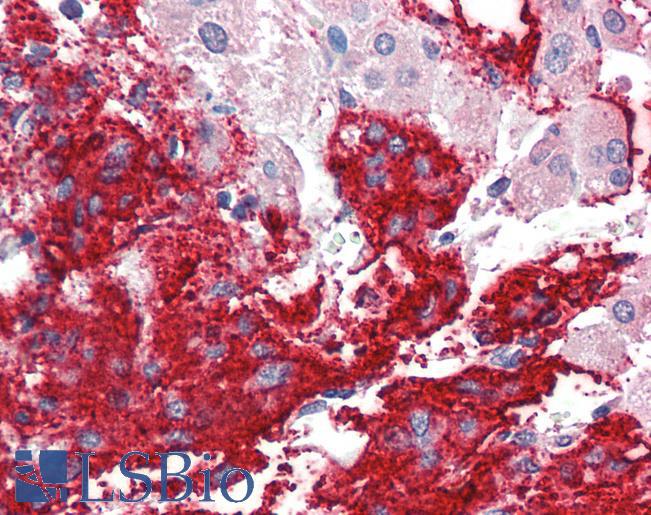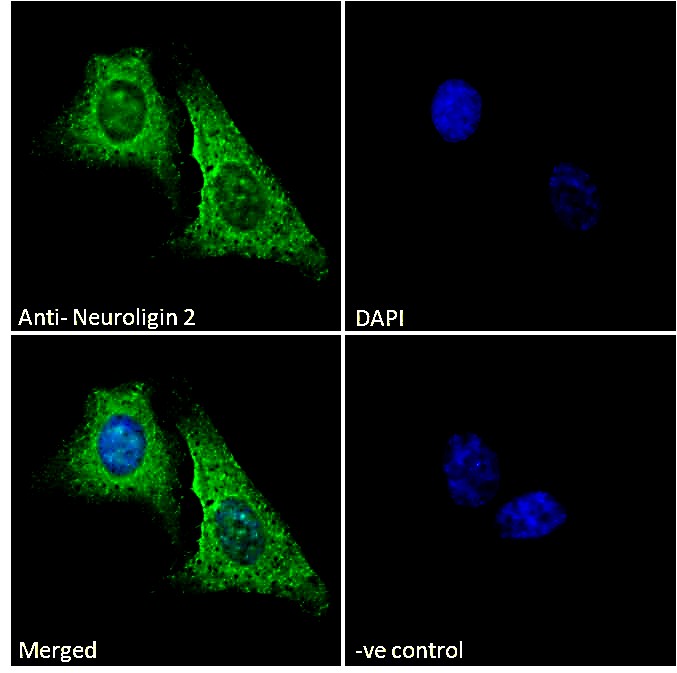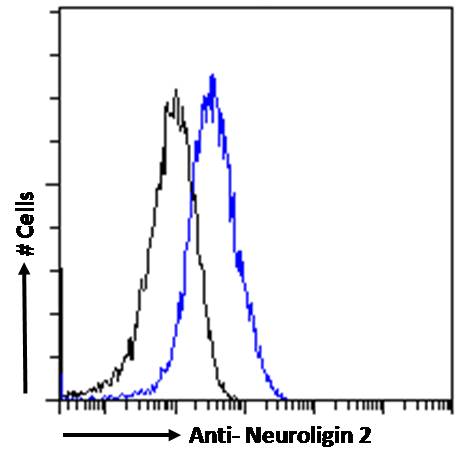Goat Anti-Neuroligin 2 Antibody
Peptide-affinity purified goat antibody
- SPECIFICATION
- CITATIONS
- PROTOCOLS
- BACKGROUND

Application
| WB, IF, FC, Pep-ELISA |
|---|---|
| Primary Accession | Q8NFZ4 |
| Other Accession | NP_065846, 57555, 216856 (mouse), 117096 (rat) |
| Reactivity | Human, Rat |
| Predicted | Mouse, Dog |
| Host | Goat |
| Clonality | Polyclonal |
| Concentration | 100ug/200ul |
| Isotype | IgG |
| Calculated MW | 90820 Da |
| Gene ID | 57555 |
|---|---|
| Other Names | Neuroligin-2, NLGN2, KIAA1366 |
| Dilution | WB~~1:1000 IF~~1:50~200 FC~~1:10~50 Pep-ELISA~~N/A |
| Format | 0.5 mg IgG/ml in Tris saline (20mM Tris pH7.3, 150mM NaCl), 0.02% sodium azide, with 0.5% bovine serum albumin |
| Storage | Maintain refrigerated at 2-8°C for up to 6 months. For long term storage store at -20°C in small aliquots to prevent freeze-thaw cycles. |
| Precautions | Goat Anti-Neuroligin 2 Antibody is for research use only and not for use in diagnostic or therapeutic procedures. |
| Name | NLGN2 |
|---|---|
| Synonyms | KIAA1366 |
| Function | Transmembrane scaffolding protein involved in cell-cell interactions via its interactions with neurexin family members. Mediates cell-cell interactions both in neurons and in other types of cells, such as Langerhans beta cells. Plays a role in synapse function and synaptic signal transmission, especially via gamma-aminobutyric acid receptors (GABA(A) receptors). Functions by recruiting and clustering synaptic proteins. Promotes clustering of postsynaptic GABRG2 and GPHN. Promotes clustering of postsynaptic LHFPL4 (By similarity). Modulates signaling by inhibitory synapses, and thereby plays a role in controlling the ratio of signaling by excitatory and inhibitory synapses and information processing. Required for normal signal amplitude from inhibitory synapses, but is not essential for normal signal frequency. May promote the initial formation of synapses, but is not essential for this. In vitro, triggers the de novo formation of presynaptic structures. Mediates cell-cell interactions between Langerhans beta cells and modulates insulin secretion (By similarity). |
| Cellular Location | Cell membrane; Single-pass type I membrane protein. Postsynaptic cell membrane. Presynaptic cell membrane. Note=Detected at postsynaptic membranes in brain. Detected at dendritic spines in cultured neurons. Colocalizes with GPHN and ARHGEF9 at neuronal cell membranes (By similarity). Localized at presynaptic membranes in retina. Colocalizes with GABRG2 at inhibitory synapses in the retina (By similarity). |
| Tissue Location | Expressed in the blood vessel walls. Detected in colon, brain and pancreas islets of Langerhans (at protein level) Detected in brain, and at lower levels in pancreas islet beta cells |

Thousands of laboratories across the world have published research that depended on the performance of antibodies from Abcepta to advance their research. Check out links to articles that cite our products in major peer-reviewed journals, organized by research category.
info@abcepta.com, and receive a free "I Love Antibodies" mug.
Provided below are standard protocols that you may find useful for product applications.
Background
This gene encodes a member of a family of neuronal cell surface proteins. Members of this family may act as splice site-specific ligands for beta-neurexins and may be involved in the formation and remodeling of central nervous system synapses.
References
Identification of new putative susceptibility genes for several psychiatric disorders by association analysis of regulatory and non-synonymous SNPs of 306 genes involved in neurotransmission and neurodevelopment. Gratac貌s M, et al. Am J Med Genet B Neuropsychiatr Genet, 2009 Sep 5. PMID 19086053.
Mutations of the X-linked genes encoding neuroligins NLGN3 and NLGN4 are associated with autism. Jamain S, et al. Nat Genet, 2003 May. PMID 12669065.
Generation and initial analysis of more than 15,000 full-length human and mouse cDNA sequences. Strausberg RL, et al. Proc Natl Acad Sci U S A, 2002 Dec 24. PMID 12477932.
Synapse formation: if it looks like a duck and quacks like a duck .... Cantallops I, et al. Curr Biol, 2000 Sep 7. PMID 10996085.
Neuroligin expressed in nonneuronal cells triggers presynaptic development in contacting axons. Scheiffele P, et al. Cell, 2000 Jun 9. PMID 10892652.
If you have used an Abcepta product and would like to share how it has performed, please click on the "Submit Review" button and provide the requested information. Our staff will examine and post your review and contact you if needed.
If you have any additional inquiries please email technical services at tech@abcepta.com.













 Foundational characteristics of cancer include proliferation, angiogenesis, migration, evasion of apoptosis, and cellular immortality. Find key markers for these cellular processes and antibodies to detect them.
Foundational characteristics of cancer include proliferation, angiogenesis, migration, evasion of apoptosis, and cellular immortality. Find key markers for these cellular processes and antibodies to detect them. The SUMOplot™ Analysis Program predicts and scores sumoylation sites in your protein. SUMOylation is a post-translational modification involved in various cellular processes, such as nuclear-cytosolic transport, transcriptional regulation, apoptosis, protein stability, response to stress, and progression through the cell cycle.
The SUMOplot™ Analysis Program predicts and scores sumoylation sites in your protein. SUMOylation is a post-translational modification involved in various cellular processes, such as nuclear-cytosolic transport, transcriptional regulation, apoptosis, protein stability, response to stress, and progression through the cell cycle. The Autophagy Receptor Motif Plotter predicts and scores autophagy receptor binding sites in your protein. Identifying proteins connected to this pathway is critical to understanding the role of autophagy in physiological as well as pathological processes such as development, differentiation, neurodegenerative diseases, stress, infection, and cancer.
The Autophagy Receptor Motif Plotter predicts and scores autophagy receptor binding sites in your protein. Identifying proteins connected to this pathway is critical to understanding the role of autophagy in physiological as well as pathological processes such as development, differentiation, neurodegenerative diseases, stress, infection, and cancer.





